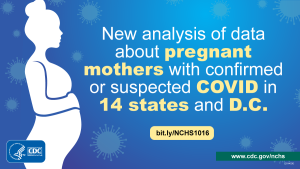New Report Looks at Pregnant Mothers with Confirmed or Presumed COVID in 14 States and D.C.
Posted on by NCHS has released a new report, “Trends In Characteristics of Mothers With Confirmed or Presumed COVID-19 During Pregnancy: 14 States and The District of Columbia, July 2020‒June 2022,” that looks at changes by maternal age, educational attainment, race and Hispanic origin, and principal source of payment for the delivery. The report includes data from the District of Columbia and 14 states: Alabama, Alaska, Arkansas, California, Idaho, Maine, Maryland, New Hampshire, North Dakota, Ohio, Oklahoma, Oregon, Tennessee, and West Virginia.
NCHS has released a new report, “Trends In Characteristics of Mothers With Confirmed or Presumed COVID-19 During Pregnancy: 14 States and The District of Columbia, July 2020‒June 2022,” that looks at changes by maternal age, educational attainment, race and Hispanic origin, and principal source of payment for the delivery. The report includes data from the District of Columbia and 14 states: Alabama, Alaska, Arkansas, California, Idaho, Maine, Maryland, New Hampshire, North Dakota, Ohio, Oklahoma, Oregon, Tennessee, and West Virginia.
Findings from the Report:
- From July 2020-June 2022, the percentage of mothers younger than 30 who had COVID-19 during pregnancy decreased 17%. The percentage of mothers ages 30 and older with COVID-19 during pregnancy increased 27% in the same period.
- By comparison over this time, the percentage of mothers under age 30 who did not have COVID-19 declined 5%, while the percentage of mothers ages 30 and over without COVID-19 increased 5%.
- From July 2020‒June 2022, mothers with COVID-19 during pregnancy tended to be younger than mothers without COVID-19, but the differences generally diminished over time.
- In the late summer and early fall of 2020 (Q3 2020), mothers with COVID-19 were 22% more likely to be under age 30 and 23% less likely to be ages 30 and older than mothers without COVID-19.
- By late spring and early summer of 2022 (Q2 2022), mothers with COVID-19 were 7% more likely to be under age 30 and 6% less likely to be ages 30 and over.
- From July 2020 through June 2022, mothers with COVID-19 during pregnancy tended to have lower educational attainment than mothers without COVID-19 (there were exceptions in Q2 2021 and Q2 2022).
- From July 2020 through June 2022, mothers who had COVID-19 were more likely to be Black or White, and less likely to be Asian, compared with mothers who didn’t have COVID-19.
- From July 2020‒June 2022, mothers who had COVID-19 were more likely to be covered by Medicaid than mothers who didn’t have COVID-19, except in Q2 2021.
Posted on by
Page last reviewed: June 28, 2023
Page last updated: June 28, 2023
Content source:
CDC, National Center for Health Statistics

